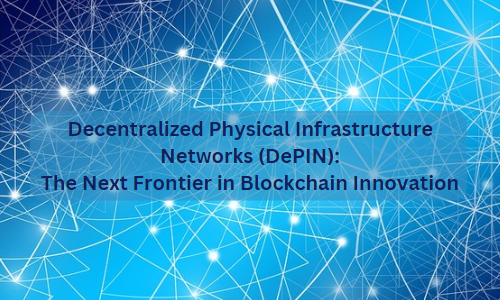

%20-%20The%20Next%20Frontier%20in%20Blockchain%20Innovation.png)
In the rapidly evolving world of blockchain and cryptocurrency, a new concept is capturing the imagination of enthusiasts and experts alike: Decentralized Physical Infrastructure Networks (DePIN). This innovative approach is poised to revolutionize how we think about and manage physical infrastructure, and it's generating significant buzz in the crypto community. But what exactly is DePIN, and why is it becoming such a hot topic? Let’s delve into this exciting development and explore its potential implications.
Decentralized Physical Infrastructure Networks (DePIN) refer to a groundbreaking model that leverages blockchain technology and decentralized systems to manage and coordinate physical infrastructure. Unlike traditional infrastructure models, which are typically centralized and controlled by a few major entities, DePIN aims to distribute control and ownership across a network of participants. This decentralization can lead to more efficient, transparent, and secure infrastructure management.
To understand the impact of DePIN, it's useful to first consider how traditional infrastructure systems operate. Typically, physical infrastructure such as utilities, transportation networks, and communication systems are managed by centralized entities—be it government agencies, private corporations, or monopolistic utilities. While this model has served us well in many respects, it also has its drawbacks, including inefficiencies, high costs, and vulnerability to failures or cyberattacks.
At the core of DePIN is blockchain technology, which enables decentralized and transparent management of digital assets and information. Blockchain operates as a distributed ledger that records transactions across a network of computers, ensuring that data is secure, tamper-proof, and accessible to all participants in the network. By applying these principles to physical infrastructure, DePIN seeks to overcome the limitations of centralized systems and introduce a new paradigm for managing essential services.
DePIN involves several key components that differentiate it from traditional models:
Decentralized Networks: DePIN utilizes decentralized networks to manage infrastructure, allowing for distributed control and coordination. This system relies on smart contracts—self-executing contracts with the terms directly written into code—that automate and enforce agreements between parties without the need for intermediaries.
Tokenization: Infrastructure assets can be tokenized on the blockchain, representing ownership or stakes in these assets through digital tokens. This tokenization opens up new opportunities for investment, crowdfunding, and community ownership, democratizing access to infrastructure projects.
Incentive Structures: DePIN systems often incorporate incentive mechanisms to encourage participation and maintenance. For instance, users who contribute to the network—whether by providing resources, data, or services—can be rewarded with tokens, aligning individual interests with the overall health and success of the infrastructure.
The applications of DePIN are diverse and potentially transformative. Here are a few areas where DePIN could make a significant impact:
Utility Services: Imagine a decentralized energy grid where community members generate, share, and consume energy. DePIN could lead to more efficient and resilient energy systems, reduce costs, and enhance sustainability by minimizing reliance on central power plants.
Transportation: Decentralized transportation networks could revolutionize public transit and logistics. Concepts like decentralized ride-sharing platforms or autonomous vehicle fleets managed by smart contracts could optimize routes, reduce congestion, and lower costs.
Communications: In the realm of telecommunications, DePIN could enable community-owned internet networks or decentralized data centres, providing more equitable access and reducing the power of traditional telecom giants.
DePIN offers several compelling advantages over traditional infrastructure models:
Increased Efficiency: By decentralizing control, DePIN can reduce overhead costs and streamline operations, making infrastructure management more efficient.
Enhanced Security: Decentralized systems are generally more resilient to cyberattacks and failures. The distributed nature of blockchain ensures that a single point of failure does not compromise the entire network.
Greater Transparency: Blockchain's immutable ledger provides a transparent record of transactions and operations, enhancing accountability and trust in infrastructure management.
Despite its potential, DePIN also faces several challenges:
Scalability: Managing large-scale infrastructure with decentralized systems can be complex. Ensuring that the technology can handle significant volumes of data and transactions is crucial.
Regulation: The regulatory landscape for decentralized infrastructure is still developing. Existing laws may need to adapt to accommodate these new models, and navigating regulatory requirements can be a challenge.
Adoption Barriers: Transitioning from traditional systems to decentralized models may encounter resistance from established industry players and require significant technological and financial investments.
Several DePIN projects are already making waves. For instance, decentralized energy initiatives and community-owned wireless networks are proving the viability of this approach. As technology continues to advance and adoption grows, we can expect to see more innovative applications and success stories.
The future of DePIN is bright, with potential trends pointing toward broader adoption and more sophisticated implementations. Its impact on the cryptocurrency market could be profound, opening up new investment opportunities and reshaping how we think about infrastructure.
Decentralized Physical Infrastructure Networks (DePIN) represent a revolutionary shift in how we manage and interact with physical infrastructure. By leveraging blockchain technology, DePIN promises to enhance efficiency, security, and transparency in infrastructure management. While challenges remain, the potential benefits make it an exciting area to watch. As DePIN continues to evolve, it could very well become a cornerstone of the future infrastructure landscape.
Disclaimer: This article is provided for informational purposes only. It is not offered or intended to be used as legal, tax, investment, financial, or other advice.
